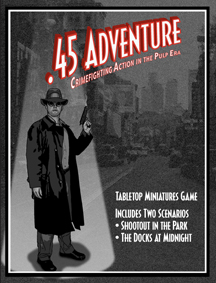|
|
|||||
 |
|
The Rules Directory only works if you help. Write a review. Get the review template here. |
|
TITLE: .45 Adventures: Crimefighting Action in the Pulp Era AUTHOR: Richard Johnson PUBLISHER: Rattrap Productions PUBLICATION DATE: 2006 WEB SITE/SUPPORT FORUM: Player support can be obtained on the Speakeasy Forum. PRICE (with date): $16.00 (in 2008) REVIEWED BY: Mark “Extra Crispy” Severin PERIOD COVERED: The Pulp Era/Genre THE BOOK: .45 Adventures is a perfect bound book of 76 pages. The rules themselves comprise 20 pages. The remainder of the book is devoted to player aid charts, character generation and sample scenarios. The book features generous examples illustrated with black and white diagrams and photos. SCOPE: The game is organized more around small scenes. ARMY SIZE: This is a skirmish game with each player controlling just a few figures. A typical scenario calls for each player to have between 1 and 6 figures. BASE UNIT: Each figure represents on character/person. GAME SCALES:
BASING SIZES: Basing is strictly for functional/aesthetic purposes. Bases have no role in game play. TURN SEQUENCE: Instead of a sequence of phases, .45 Adventures is built around actions. At the beginning of a turn, each player rolls a die for initiative. Play proceeds by a combination of initiative and character Dodge ratings (see Character Ratings, below). The character with the highest Dodge score moves first. If there are multiple characters with the same Dodge score they move in order of the initiative roll (ties ar resolved via further die rolls as needed). When it is a character’s turn to move, he or she may perform one of a number of actions. GAME MECHANICS: Character Ratings: Each character in the game has a “Stat Line.” Each stat represents a different attribute or ability of that character. These stats are:
Each stat has a corresponding hit/damage location. Thus, as the Torso suffers damage both Guts and Brawn stats will suffer. Actions: When it is their turn a character may take an action. Actions include moving, climbing, firing (aimed or not), going prone, waiting. Most actions require a stat test. Stat tests are always the same. Roll a ten-sided die. Add the relevant stat. If the result is 10 or more the character has successfully performed the desired action. Tests may be subject to die-roll modifiers based on difficulty, conditions, etc. Hero Points: At the beginning of the game each player is assigned a number of Hero Points. Hero Points can be used to add 1 to a measurement, stat or die roll. A player can use two points and then re-roll a die. They can also be used to add 1” to a move, the range of a weapon, the strength of a weapon, or even the character’s defensive rating. Once used they are gone. Combat: Combat is resolved by opposed die rolls. The attacker rolls a D10 and adds his relevant stat. The defender does the same. Both die rolls may be subject to modifiers for cover, weapons, wounds, etc. If the attacker has the higher roll he has scored a hit. Whenever a model is hit, the location is determined by a die roll. Then the DR of that location is compared to the attacker’s WS rating. If the WS is higher than the DR one damage box for that location is marked off. If the WS is twice the DR two boxes re marked off - if three times higher three boxes are marked off. If the DR is higher than the WS the hit model makes an Armor Save. He rolls D10 and adds the difference between the WS and the DR. If the result is 10 or more, no damage is inflicted. Otherwise one damage box is marked off. Generally two head hits or 3-4 torso hits will kill. Hits to arms and legs slow down the character but are not fatal. Guts Check: Each time a model is wounded it must make a Guts check. If it fails it must move to leave the board. It may do a new gut check every turn until it rallies or leaves the board. Additional Rules: The book contains a number of additional rules including a short chapter on vehicles; explosives; disarming and suppressing fire. ARMY LISTS/SCENARIOS: The book includes an extensive chapter on developing characters. It provides a number of archetypes ranging from a Cub Reporter to Foreign Agent. It includes lists of special abilities, weapons stats, etc. There are also two complete scenarios provided. REVIEWER’S COMMENTS: .45 Adventures is a nicely put together set of rules. Very well play tested and supported, it has spawned an entire range of supplements and “sister-rules.” The rules are well thought out, easy to read and have extensive charts and examples. PLAYER’S COMMENTS: Not played. To read comments by others or leave one yourself, please click here. |
|
[Home] [15mm World] [Reviews Home] [How To] [Beginners Guide] [Gamer's World] [Spanner & The Yank] [Points of View] [The Annex] [Links] [Say Howdy] [Corporate Schill] [Rules Directory] |
 |
